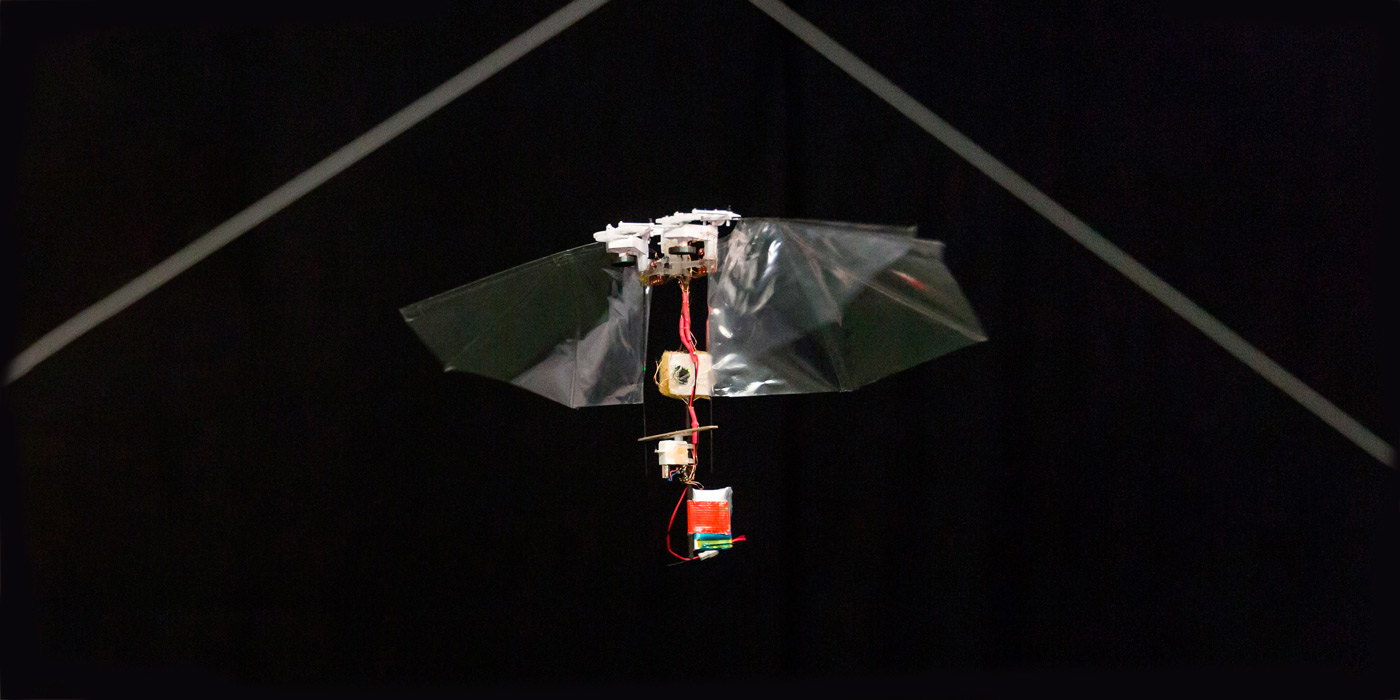Fruit fly is not the first association that comes to mind when looking at the 30cm wingspan of the Delfly Nimble. The aerial acrobatics of it do, however, very much mimic fruit fly behaviour. This allowed its developers to test important assumptions about how these flying insects perform their evasive manoeuvres. Their recent publication in Science is only the beginning of what flying robots can teach us about insect flight.
The Nimble is the newest in a line of micro-air vehicles developed by researchers at the TU Delft MAVLab. “It is our first insect like robot that doesn’t have a plane-like tail,” said Dr Matěj Karásek, post-doctoral researcher at the MAVLab. “Just like insects, our robot uses only its wings to initiate rotations around any of its three body axes.” According to Dr Guido Croon, scientific director of the MAVLab, “Nimble is an important step towards our ultimate goal of lightweight, safe and smart drones. Because of its agility, Nimble can operate effectively in much harsher wind conditions than our previous tailed drones.”
Inspired by nature
Imagine the Nimble standing up, like a person. For rotations around its head-to-foot axis (known as yawing), the Nimble pushes the ‘bottom’ of both wing pairs in opposite directions, angling both wings pairs with respect to each other. For rotations around its left-to-right axis (known as pitching), it pushes both wing pairs towards its back or belly. “Both strategies are similar to the method used by fruit flies and many other insects,” Karásek said. “Rolling is an exception. For a sideways rotation (around their front-to-back axis), a fruit fly varies the amplitude of its wing motion, while we change the flapping frequency on one side of Nimble’s body. We don’t copy nature, we are inspired by it.” The Nimble is controlled by a tiny 2.8-gram programmable autopilot unit that also houses sensors for estimating body orientation and rate of rotation. According to Karásek, “the control algorithms are comparable to what we believe insects use.”
At the press of a button
Unless instructed to do otherwise, the Nimble will return to a hovering position, its body hanging vertically in the air and its wings flapping about seventeen times per second. But it can also use its sensors and wing motion adaptation to follow pre-programmed commands, initiated through a remote controller. “These pre-programmed manoeuvres include aerial tricks such as 360-degree flips, but also turns inspired by the escape manoeuvres of real fruit flies,” Karásek said. “We press a switch to initiate the motion, and only when the Nimble recovers do we get back control.”
Nature’s code
“Fruit flies can drive us crazy when they manage to repeatedly escape our attempts at swatting them,” Karásek said. “Scientists have tried to explain how fruit flies perform these manoeuvres, based on observations made with high-speed cameras. But for confirmation one would need to look into the animal’s brain. Our insect-like Nimble provides an alternative approach.” In a collaboration with Florian Muijres, biologist and assistant professor at Wageningen University & Research, MAVlab researchers programmed the robot to replicate the fruit fly manoeuvres. When they compared its flight trajectories to those of fruit flies, there were remarkable similarities.
Capturing insect flight
“Our most important finding may be the discovery of a new aerodynamic effect assisting the fly in making turns,” said Karásek. “For both fruit flies and our robot, we observed rotations around the head-to-foot axis. But for our robot we were certain this was a passive phenomenon as we had disabled its yawing mechanism. This rotation is initiated by a combination of body translation and the adjusted wing motion, necessary to initiate rotations around the other axes.” The researchers were able to capture this complex mechanism, assisting the fly in turning its body into the escape direction, in a surprisingly straightforward equation.
Nimble as a bee
Their research with Nimble has already resulted in a publication in Science. But, according to Karásek, “there is so much more that our robots can teach us about insects. And there is so much more that we can learn from insects to improve our robots.” In their NWO-funded project, “To be as nimble as a bee”, they are again collaborating with Wageningen University & Research. They will look at how insects handle sudden wind gusts. They also want to understand why different insects have different sensory systems. “Fruit flies use so-called ‘halteres’, biological gyroscopes, to provide information about their body rotation during flight. The gyroscopes in our autopilot unit are actually based on the same principle. But certain flying insects do not have halteres, and yet they are flying perfectly fine. What sensors are involved and how do they use them?” asked Karásek.
Smaller and smarter
The current Delfly Nimble has only limited autonomy. Sure, it flies wirelessly, but its behaviour is completely governed by a few hundred lines of code and by external commands. The Nimble is also blind. It has to be steered or it will bump into objects. “Nimble will have the onboard intelligence to fly autonomously using only a single camera,” said Croon. “And we have already developed the wireless technology to have our drones operate in swarms.” Karásek expects to be able to scale down the size of the robot. He explained that “at small scales, flapping wing robots fly more efficiently compared to traditional quadcopter drones.” When asked for a futuristic application for such agile, small and smart drones, Karásek said, “imagine a swarm of miniaturized Nimbles, flying autonomously in a greenhouse, pollinating flowers.”
More information:
- Here you can see a movie of Delfly Nimble.
- The publiciation in Science is available here.
